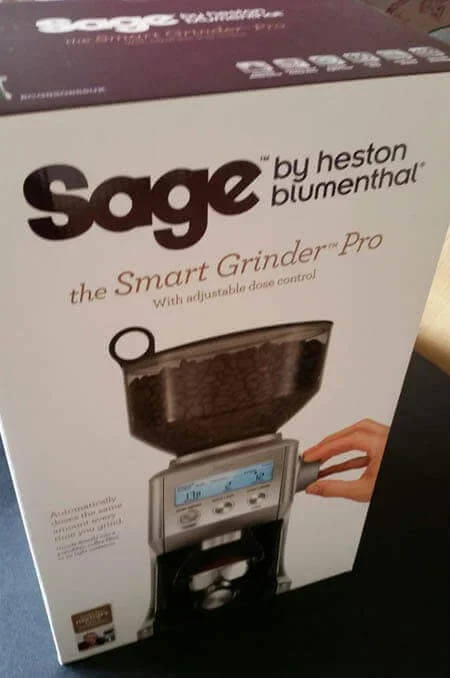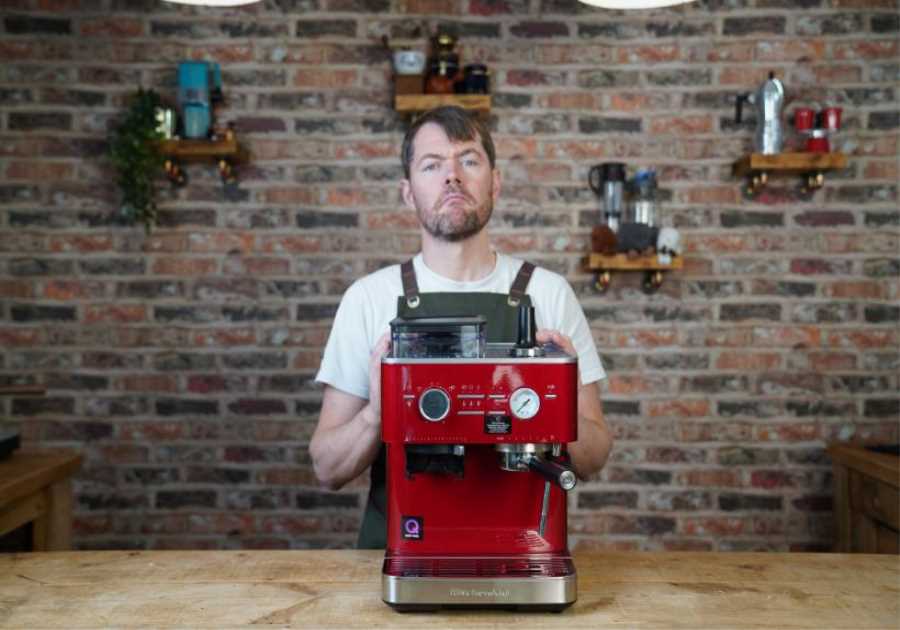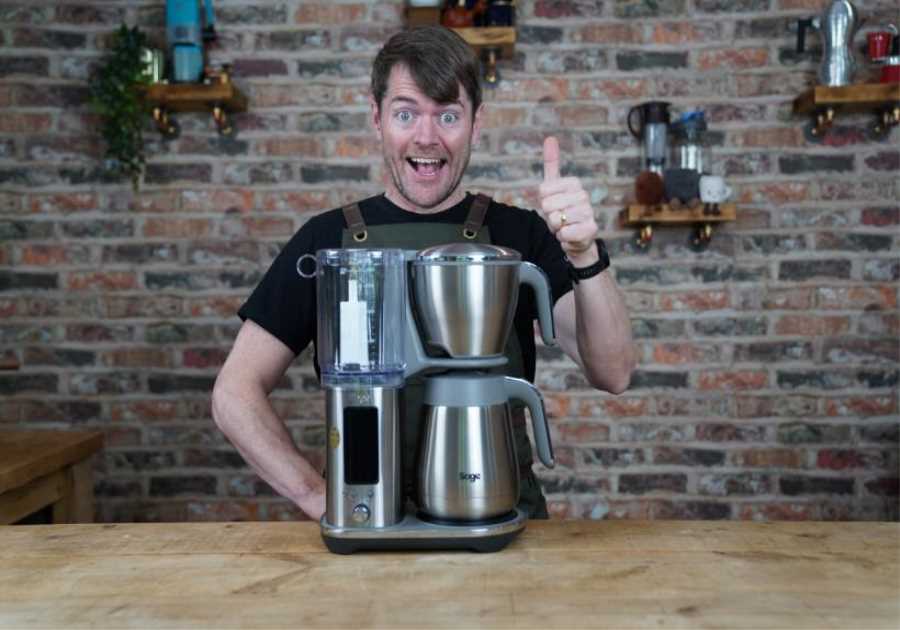This is my Sage Smart Grinder Pro review, written over a period of now four years! I started the review at unboxing & first use, and then continued to update the review over the years as I continued to use it.
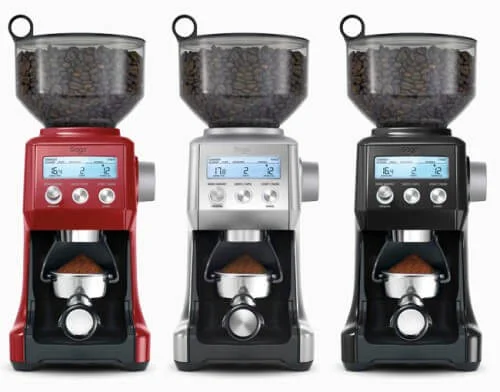
Check Price - Amazon UKCheck Price - Sage Appliances
This started at the beginning of April 2016, so I’ve now been using the Smart Grinder Pro for almost five years!
There are many reviews of the Sage Smart Grinder Pro, but I don’t think you’ll find many full user reviews like this, written over such a long period of use.
Carry on reading to see what I think after all this time, and whether I’d recommend it.
Background
A while back (almost 5 years ago now at the last time this post has been updated) I was looking at budget coffee grinders.
I quickly disregarded the “blade” grinders, as I knew that you needed burrs to grind, and that anything with blades wasn’t going to achieve the same thing.
I did have a look at the grinders at the very entry-level, the cheapest budget grinders such as the De’Longhi KG79 coffee grinder, but I wanted something a bit more capable and also a bit nicer to use.
Also, I didn’t want to spend several hundred pounds on a coffee grinder. At the time, I was thinking around £100.
After doing some research I came to the conclusion that I was probably going to have to up it to somewhere close to double this in order to get a decent machine which is capable of fairly good results for espresso and other brew methods.
The obvious choice appeared to be the Sage Smart Grinder Pro.
At the time (and it’s the same now) there wasn’t really anything that appeared to be as good across the board, including ease of use, reliability and compatibility with most brew methods including espresso, for this kind of price.
I’d already experienced a Sage machine at that time with the Sage Oracle, which they sent to me on loan to use in order to create my Sage Oracle review, so I was already under the impression that Sage (Breville everywhere else) make decent machines.
So I decided on the Sage Smart Grinder Pro. It ticked all of the boxes for me, in theory, and given that I was wanting to grind for a wide range of different brew methods, espresso included, I couldn’t see many other options without upping the budget.
By the way, there’s also the Sage dose control pro, which is cheaper, it doesn’t quite have the same bells and whistles as the Smart Grinder Pro, but it seems like a great grinder for the cost.
The motor has a bit less power, 130w & you choose the grind size by turning the hopper vs the dial and the LED grind size display on the Smart Grinder Pro.
Also it lacks the programmability of its slightly bigger sibling – so it’s basically a slightly feature-stripped lower priced version.
So anyway, without further waffle:
Sage Smart Grinder Pro Review
After almost five years of use! (first written in April 2016, when I first bought the grinder, & updated periodically).
I bought the Sage Smart Grinder pro at the beginning of April 2016, directly from Sage Appliances. I began creating this review at unboxing, then at first use, and then I continually updated the review over the past few years.
Unboxing
As was the case when Sage sent me the Oracle to use temporarily, for my Sage the Oracle review, this machine is packaged very well. It was delivered via UPS, the retail box was inside another thick box, like a Russian doll.
So I opened the outer box, took out the retail box, then the smart grinder was very carefully packaged in protective molded packaging inside this box, so they do their best to make sure it gets to the customer in one piece.
This is important, it’s a real pain in the rear taking delivery of something you’ve been waiting for, and then finding it’s been damaged by heavy-handed couriers.
There is a quick start guide in the box, which tells you the steps to take, and it’s literally a case of rinse the hopper out, rinse the grounds container out, plug it in, put coffee beans in the hopper; very simple indeed!
First use
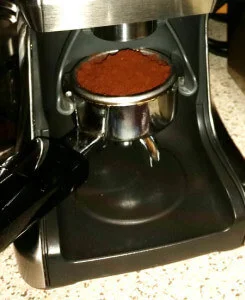
It comes with a nice handy heavy duty plastic air tight grounds container, and with measurements on the side, and also with two porter filter cradles.
One for standard 58mm portafilters for use with espresso machines such as the Gaggia Classic.
One for the smaller 54mm portafilters for use on some of the Sage machines including the brilliant Sage Bambino Plus.
I struggled a bit at first to get the portafilter into the cradle, and then realised I was being a muppet.
I just needed to put the handle to the left hand side as I do when I’m inserting the portafilter into the slots on the group head before I lock it in place, so that the bits that stick out on the side, rest on the cradle. This was with my Gaggia classic, which I was mainly using at that time.
The knob on the right hand side adjusts the grind size.
I wanted espresso grind so I turned the dial until the arrow on the LCD screen went up into the “espresso” range – can’t get much more simple than that really, although you do need to dial in to find the right grind for the coffee you’re using.
I pressed the “shots/cups” button to tell it to grind enough for a double shot, and this automatically set the grind time to 17.8 seconds. I could see that I can adjust the grind time with the dial on the front, and I wasn’t sure at first why I would want to do that.
Again I realised I was being a muppet, this is just the way that you adjust to grind more, or less coffee than the automatically resulting grind time based on the number of shots/cups.
For example by default it grinds for 17.8 seconds for a double espresso shot, which is usually just about perfect for my 58mm portafilter and double basket.
But if I found it wasn’t enough, well first I could press and hold the start/pause button to grind just a bit more – but then next time I could just adjust the grind time slightly to 18 seconds for instance.
You can actually program the grinder too, to change the amount it grinds by default per cup/shot for that particular brew method. For instance, you can change it to set the default grind time for 18 seconds for a double espresso shot, without making any difference to the grind time for drip.
I adjusted the grind to dial in the bean, which simply put means to grind finer if it flows too fast, and grind more coarse if it flows too slow.
By the way, there are various recipes & brew ratios you can follow, but I usually go for 1:2 extraction in 28-32 seconds. This is just how I was trained when I did my barista training a few years back.
So if you’re grinding 18 grams in a double basket, you’d be looking for a 38g shot of espresso in around 28-32 seconds.
This is if you’re using a machine with standard baskets. If your espresso machine comes with pressured baskets, you still want to pay attention to ratio, but the flow rate goes out of the window with pressured baskets, you can’t dial in that way with them.
Anyway…
So in all, first use, really good, very simple – such a clever machine!
I continued to use the machine for a couple more days, before continuing with the review, and this review has been continually updated over the past nearly 5 years, at the time of writing.
Looks

I really like the way this machine looks, it’s mainly stainless steel, with a bit of black plastic on the inside.
It’s a really compact machine, the footprint is only 16cm x 21cm (just over 6×8 inches), and right to the top of the hopper it’s just over 38cm (roughly 15 inches) tall, which is almost identical to my Gaggia Classic in terms of height.
There is plenty of clearance over the top before the bottom of the kitchen wall cupboards.
Everything about it just looks classy and high quality to me, and in my opinion Sage (or Breville as they’re known outside of the UK) really know how to design slick looking machines.
Ease of use
It’s a doddle!
The big knob on the right hand side controls the grind size, and you can take it straight into the desired range, i.e. into the espresso range and then test and tweak from there.
You can tell the machine how many cups or shots you wish to grind, and you can very easily adjust the grind amount by turning the grind time dial as I mentioned earlier.
There’s really nothing about it that requires much thought, it’s all designed very cleverly.
By the way – a quick note on dialing in the bean.
You’ll need to “dial in” to get the right grind size for each new bag of beans, but even with the same beans you will find with any grinder, even with commercial grinders, that you need to tweak the grind over time.
For example you might find the perfect grind size with the beans in the morning, and go to pull another shot the next day with the same bean and find that you have to adjust slightly as it’s either running too slow, or too fast, at that grind setting.
I find a good starting point with freshly roasted coffee beans for Espresso is around 10-12, but you may find it’s different with your Espresso machine.
If grinding for Aeropress I usually start at the courser end of Espresso. Similar for The Oomph although the oomph doesn’t seem to be as sensitive to the grind.
For pour over, Chemex, V70, Kalita etc., I’m usually quite a bit courser, 40-50 ish, and for cafetiere much more course, somewhere from 50s upwards. These are just guesstimates, you’ll have to do some experimenting.
Features
I’ve been using this machine for almost five years now, so I’m including features here that I have found useful myself, rather than just the obvious features that will be covered in the sales blurb.
This machine has so many clever features, but I think probably the number one for me over the past couple of years, has been the ease of adjusting the grind size and clearly being able to see this via the LED display.
This was really highlighted for me when I recently did my Barista training using a very expensive commercial grinder, with a mechanical grind adjustment wheel which many grinders have – and I found it really difficult to know what I was doing when adjusting the grind, trying to get dialled in.
When I got home and got back to using the Sage smart grinder pro, I realised that, amazingly, I found my sub £200 home grinder to be much more intelligent when it came to communicating with me where we were going with the grind, and therefore much easier to get dialed in, than with a grinder that costs roughly twenty times the price!
You just turn the dial on the side, and you see the grind number changing on the LED display, from 1-60. Not only this but it tells you on the screen when you’re within the range for each brewing process.
You can see very clearly, for example, when you’re in the Espresso range, and filter range or cafetiere range – although after a while you’ll probably find that, like me, you don’t use the ranges as you know roughly what number you need to be at for each brew process.
So although the Sage dose control pro is almost the same machine at about thirty or forty quid less, I wouldn’t want to lose this feature, as it makes it so much easier for dialing in – and it would be easy to lose £30-40 worth of coffee over the life of the machine due to taking longer getting dialed in, I’m sure!
When you put the portafilter cradle on, by the way, the grinder automatically changes the options on the screen from “cups” to “shots”, and gives you the option to grind for a single or double shot, it’s a really intelligent machine!
Sage really are good at making super user friendly & beginner friendly machines.
Having such a wide range is also a great feature, there are 60 settings via the dial, but actually, there are 60 settings for each manual adjustment with the burs, so I suppose in theory there are 600 settings ;-).
What I mean by this, is that you can very simply adjust the burs manually to shift into a finer or more coarse range, by taking the wire handle from the burrs and then adjusting the setting on the burrs from 1-10.
I think the idea with this is that if the burrs wear over time, you can manually adjust accordingly – although I’ve not had any reason to do so as yet, and I’ve ground a lot of coffee with this grinder!
Removing the burrs to clean is very quick and simple.
Again, to compare this with breaking down and cleaning the commercial grinder I was practicing with during Barista training, the smart grinder pro is an absolute doddle in comparison.
The hopper is nice and big, much bigger capacity than most other affordable home coffee grinders – it will take nearly half a kilo!
Most of the time I only put what I’m grinding in the hopper at any given time, but if I’m making a lot of coffee I’ll just pour the whole bag in. The hopper has a rubber gasket to keep the beans fresh while in the hopper – this is a feature that even most commercial grinders don’t have.
When you unlock the hopper to remove it from the grinder, the hopper seals, meaning that you don’t end up with coffee beans everywhere, and you can put the hopper over a bag & dump them in there. This seems like common sense, but not all grinders have this feature.
The fact that it has a removable grinds catcher that you can just slide out to dump any loose grinds is a handy feature too, as is the fact that the grinds catcher and the portafilter cradles have magnets on to snap them into place.
You can program the grind time per shot or cup for each brew type, which I think is a good feature, as is the fact you can start the grind by pushing in the portafilter in, or pressing the start/pause button, and that you can grind freely by pressing and holding the start/pause button until you’ve ground the required amount.
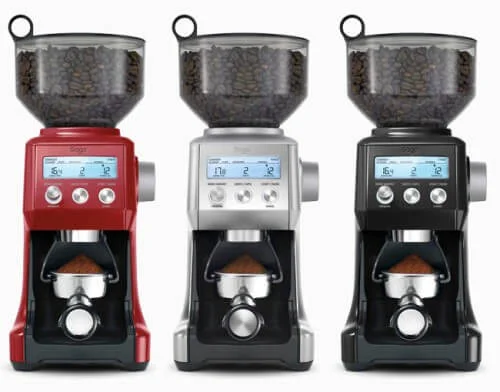
Noise
This is something else that I think is fairly important, I noted from some of the other reviews of the various grinders I was looking at, that some of them were particularly loud, or produce a tone that makes it appear louder.
I don’t think it’s possible to grind hard coffee beans silently, but the sound of the smart grinder pro grinding is not at all a deafening noise, in fact I don’t find it to be loud at all.
That being said, I am a drummer, and for many years I didn’t wear ear plugs when I really should have, and I’m a loud drummer; the guitarists in the bands I’ve been in have been just as loud, so my hearing isn’t the greatest.
Joking apart though this isn’t the loudest of grinders, and I think it’s more about the tone than anything. If you watch the various reviews and comparisons, you’ll find that the smart grinder pro is usually found to be quieter than other grinders.
Speed
To me, it’s plenty quick enough, and seems like hyperdrive in comparison to hand grinding. On my current settings, it’s set at 17.8 seconds to grind for a double shot.
From what I can gather this is maybe just under a second slower than the Mazzer Mini, which several hundred pounds, so that’s not a bad comparison for a machine costing a heck of a lot less. Like all grinders of course the more coarse the grind, the faster it will grind – and when I’m grinding for V60, Oomph, Aeropress etc., it’s far quicker than when I’m grinding for Espresso.
Static
Something that came up often when I was researching the entry level priced grinders, was static issues, with coffee grounds for some reason getting statically charged and then sticking to everything. I didn’t see anyone complaining of this for the smart grinder pro, and I can confirm that in my case at least, there’s absolutely no issue with statically charged coffee grounds.
Mess
Again something I noted often among reviews of the lower priced grinders, was mess. This is a really clean grinder, even when I’m grinding into the portafilter which is when you’d think the grounds may miss it, it’s very rare that there’s any mess, and if there is, the grounds catcher slides out to be emptied, and then just slides back in again – and connects with a satisfying clunk thanks to the magnet on the back ;-).
Consistency
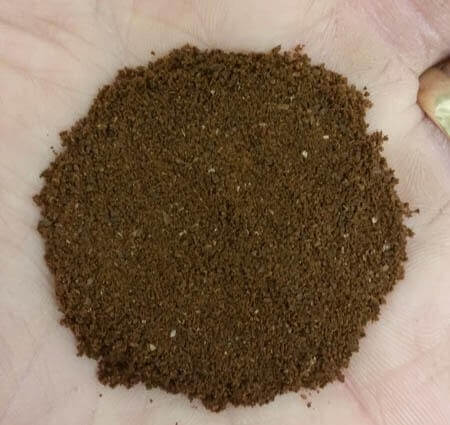
This isn’t something I’ve checked under a microscope, I’ve not measured individual coffee grinds, but visually the particle size looks fairly consistent from espresso all the way up in coarseness to cafetiere. Not a huge amount of fines or random chunks.
This is a low cost grinder, you do need to take that into account. I’m sure some of the grinders at £500 – £1000 or more will produce more consistent particle size, well you’d hope so!
But for the relatively low price, I’m very happy with the quality of the ground coffee this grinder produces.
Reliability
I’ll come back to you on that one in a few years.
I’ve seen a video in which Phil Mcnight of Breville states that you should be able to grind at least 200 Kilo’s of coffee before you even need to start making any adjustments with the machine, that’s 800 bags of 250g coffee beans!
So if they’re talking these kind of figures, I’m expecting that they’ve built these machines to last, that isn’t to say that my expectation is any guarantee of course – but there’s a 2 year warranty anyway.
Several Years Later (said with an accent like the guy on Spongebob).
I’ve been using the Sage smart grinder pro for getting on for five years at the time of writing, and I can tell you, this is a stonking little grinder for the price!
I’d wholeheartedly recommend it.
Also, I found Sage Appliances to be great when it comes to customer services. After a few months, I did something to the grinder…
I’d been trying lots of different beans from different roasters, and although I didn’t find it when taking it apart – I think I ground a small stone. From what I can tell, that’s the only thing that would have caused the issue.
I contacted Sage Appliances, and they were really helpful, I spoke to someone in support, told them what was happening, they wanted to try swapping out a part, they sent it to me free of charge and told me how to fit it, it was very simple, but it didn’t fix it.
So a couple of days later they just swapped out the machine with a brand new one!
If this had been after 2 years and it was out of warranty, I’m not sure what would have happened – but then again, this is a grinder at under £200.
I think you do need to be aware if you’re buying a machine like this, is that you may be lucky like me and have an issue within the warranty period, and then be lucky to have no issues way outside of the warranty period.
But if you’re unlucky and something gives after a couple of years, it’s unlikely you’re going to be able to repair a grinder like this.
They’re not a standard machine with an abundance of OEM components. Unless for example, the impeller goes – this is something there are firms who 3D print and is very easy to replace – anything else, and it’s really a case of chuck it and buy a new one.
But, like I say, I was lucky. The problem I had (and I think it was my fault, like I say I suspect I ground a stone) happened well inside the warranty period.
And now, almost 5 years later, my Sage Smart Grinder Pro is absolutely fine.
I’ve ground probably a good couple of hundred kilos of coffee with it, maybe more, and I’ve not even had to adjust the burrs!
If you read any comments that the Smart grinder pro doesn’t grind fine enough for espresso by the way, utter bilge.
I think this may have been an issue with the first version, the smart grinder – but it’s certainly not an issue you’ll face with the Smart Grinder Pro.
I have never once come across a bean that I couldn’t grind fine enough, paired with various different espresso machines.
In fact I’ve usually been no finer than something like 6 or 7, maybe once I had to go down to about 3 for a particular bean.
Most of the time I’ve been more like 9-11 on the grind settings for espresso with standard baskets.
I’ve tried many other grinders over the years, and overall, for the price, there aren’t many that I’d recommend over the Smart Grinder Pro – not for under £200.
If you see my best coffee grinders post, you’ll see that there are a couple of espresso-specialist grinders at a similar price that perform slightly better for espresso due to worm dial adjustment.
But overall, all things considered, I’d rate the Smart Grinder Pro as the best coffee grinder, generally speaking, for this kind of price.
Check Price - Amazon UKCheck Price - Sage Appliances
Life is like a box of chocolates, so join my Brew Time list, subscribe to my YouTube Channel, try my coffee at The Coffeeworks (use discount code coffeebotherers), follow me on Twitter & Instagram, follow the coffeeblog FaceBook page, and that’s all I have to say about that.
The post Sage Smart Grinder Pro Review – Over Four Years! appeared first on Coffee Blog.
By: KevTitle: Sage Smart Grinder Pro Review – Over Four Years!
Sourced From: coffeeblog.co.uk/sage-smart-grinder-pro-review-3/
Published Date: Thu, 07 Apr 2016 15:57:11 +0000

